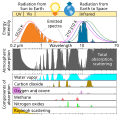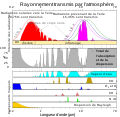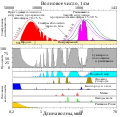Fichier:Atmospheric Transmission.svg

Taille de cet aperçu PNG pour ce fichier SVG : 614 × 600 pixels. Autres résolutions : 246 × 240 pixels | 491 × 480 pixels | 786 × 768 pixels | 1 048 × 1 024 pixels | 2 096 × 2 048 pixels | 741 × 724 pixels.
Fichier d’origine (Fichier SVG, nominalement de 741 × 724 pixels, taille : 321 kio)
Historique du fichier
Cliquer sur une date et heure pour voir le fichier tel qu'il était à ce moment-là.
| Date et heure | Vignette | Dimensions | Utilisateur | Commentaire | |
|---|---|---|---|---|---|
| actuel | 18 avril 2023 à 18:19 |  | 741 × 724 (321 kio) | Efbrazil | Adding white background color so renders correctly on smartphone |
| 7 août 2022 à 22:29 |  | 741 × 724 (321 kio) | Efbrazil | color bug fix | |
| 7 août 2022 à 22:00 |  | 741 × 724 (321 kio) | Efbrazil | Fixed translations as best as possible using text editor for new layout | |
| 7 août 2022 à 21:34 |  | 741 × 724 (320 kio) | Efbrazil | Fixing text alignment | |
| 7 août 2022 à 21:26 |  | 741 × 724 (320 kio) | Efbrazil | Graphical improvements as per discussion page | |
| 17 février 2022 à 19:59 |  | 741 × 724 (208 kio) | Pierre cb | File uploaded using svgtranslate tool (https://svgtranslate.toolforge.org/). Added translation for fr. | |
| 19 mars 2021 à 00:10 |  | 741 × 724 (180 kio) | Cepheiden | german labels adjusted | |
| 19 mars 2021 à 00:09 |  | 741 × 724 (180 kio) | Cepheiden | correction of labels | |
| 19 mars 2021 à 00:06 |  | 741 × 724 (180 kio) | Cepheiden | File uploaded using svgtranslate tool (https://svgtranslate.toolforge.org/). Added translation for de. | |
| 18 mars 2021 à 23:52 |  | 741 × 724 (154 kio) | Cepheiden | =={{int:filedesc}}== {{Information |description= {{en|1=This figure shows the absorption bands in the Earth's atmosphere (middle panel) and the effect that this has on both solar radiation and upgoing thermal radiation (top panel). Individual absorption spectrum for major greenhouse gases plus Rayleigh scattering are shown in the lower panel.}} |date=2021-03-18 |source=This figure was prepared by Robert A. Rohde for the Global Warming Art project. |author=[[User:Д.Ил... |
Utilisation du fichier
La page suivante utilise ce fichier :
Usage global du fichier
Les autres wikis suivants utilisent ce fichier :
- Utilisation sur ar.wikipedia.org
- Utilisation sur de.wikipedia.org
- Utilisation sur el.wikipedia.org
- Utilisation sur en.wikipedia.org
- Utilisation sur gl.wikipedia.org
- Utilisation sur ha.wikipedia.org
- Utilisation sur ig.wikipedia.org
- Utilisation sur pt.wikipedia.org
- Utilisation sur simple.wikipedia.org
- Utilisation sur zh.wikipedia.org









